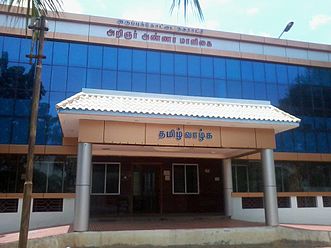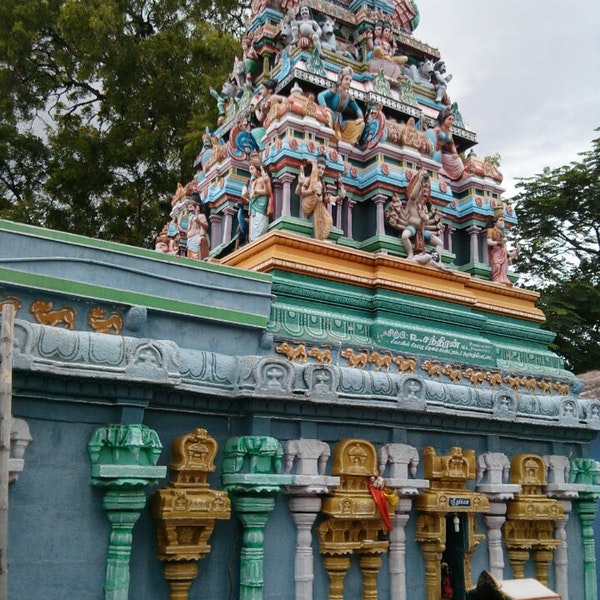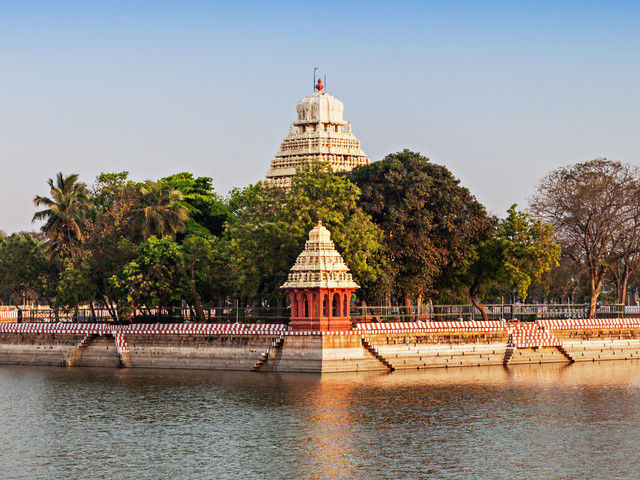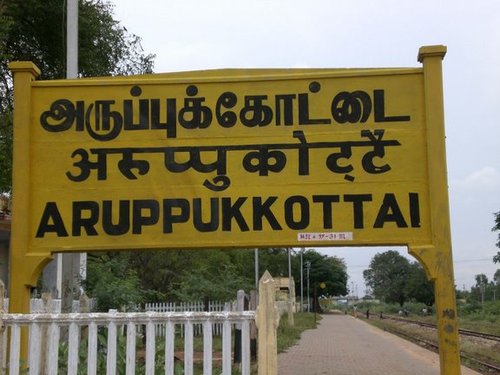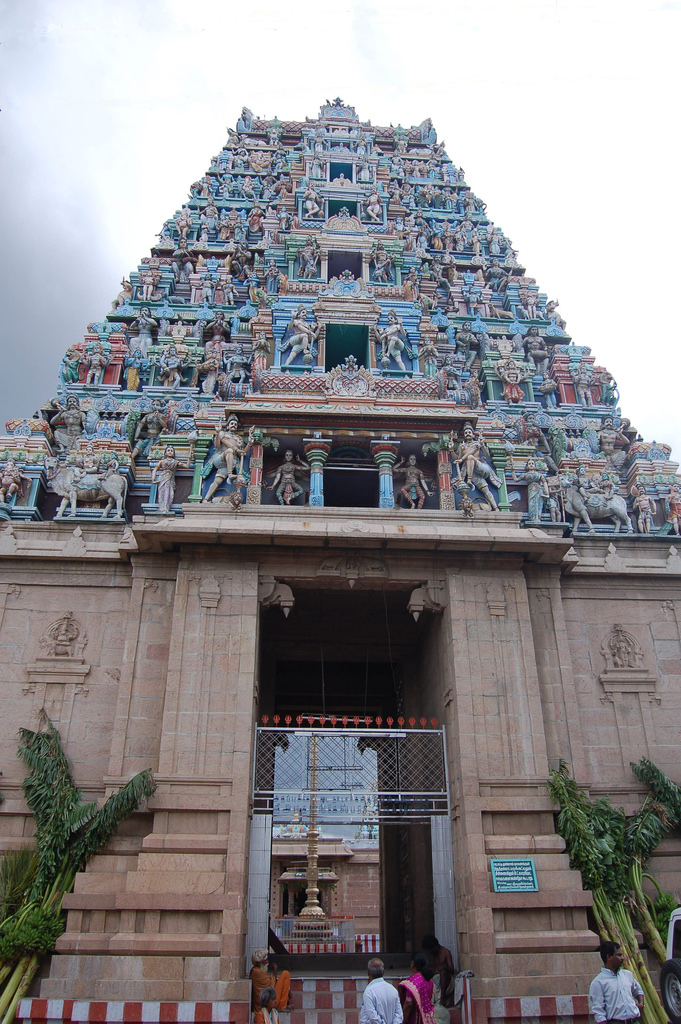Aruppukottai City
Aruppukottai City |
About: |
|
Aruppukottai town lies 50 km south of Madurai city and 20 km East of Virudhunagar town on the Tuticorin - Madurai National Highway road Extension No.49B, being a First Grade Municipality with an area of 14.96 sq. km. The town has a population of 83,999 as per the 2001 census. Aruppukottai acts mainly as an Educational and Commercial hub for the surrounding areas, mainly villages. There is an Engineering College, Two Arts & Science Colleges, and more than five Schools of Higher Secondary level. It is noted for its cotton industries and limestone industries. Sathyamoorthy Bazaar, Main Bazaar, Kasukadai Bazaar, Nadar West & East Street, Velaikottai are the main town areas. Chockalingapuram, Sengunthapuram, Kulandaivelpuram, Anna Nagar, Aziz Nagar, Periyar Nagar, Periya Theru, Maravar Theru, Thammandh Theru, Kalla Theru, Puliam Patty, Chinna Puliampatti & Peria PuliamPatti, Vadugar Kottai, Velayuthapuram, Thirunagaram, Valavanthapuram, Mani Nagaram, Therku Theru, Agraharam, Ramasamy Puram, Amman Kovil Theru, Chekkadi, Palayampatty Old Jameen Palace. Aruppukottai acts mainly as an Educational and Commercial hub for the surrounding villages. It is noted for its cotton industries, mainly spinning mills. Rice mills, limestone industries, handloom, power loom, printing press, and small-scale industries such as school notebook and daily calendar manufacturing. Handloom and power loom are the primary jobs in the Vellaikottai area. Saliyars, Mudaliyars, and Chettiars have weaving as their main occupation. Major employers are spinning mills, weaving sectors (handloom & power loom), rice mills, private transport, and the government sector apart from agriculture. Aruppukottai, located in the Virudhunagar district of Tamil Nadu, is a vibrant city with a rich historical legacy and a thriving textile industry. It is particularly renowned for its production of high-quality cotton fabrics, which are crafted using both traditional handloom techniques and modern power loom technology. The city's textile heritage has earned it a distinguished reputation, making it a key player in the region's economy. Beyond its industrial significance, Aruppukottai is steeped in cultural traditions, reflecting the deep-rooted Tamil customs that shape its identity. We can reach the Temple city Madurai within one hour from Aruppukottai. Sri Ramana Maharishi was born in Tiruchuli near Aruppukottai town. The name evolved from 'Arumbu Kottai' which means Fort of Jasmines. The small villages & towns surrounding Aruppukottai are famous for production of Jasmine flowers. It is also called the United Streets of Aruppukottai (USA). In every public exam, Aruppukottai Educational District occupies the first position in overall pass percentage. |
Location Info: |
|
Address: Triambakeshwar, Maharashtra, India District: Nasik District Nearest City: Trimbakeshwar Best time to visit: During monsoon season |
Climate/Weather: |
|
The maximum temperature during summer is 34°C and during winter it is 25°C. The minimum temperature varies from 26°C to 32°C. The mean humidity is 80.2%, which varies from 74% to 85.8%. The seasonal climate conditions are moderate, and the weather is uniformly salubrious, making it a pleasant destination to visit year-round. |
History of Aruppukottai City: |
|
Aruppukottai has a deep-rooted history that traces back to ancient Tamil dynasties like the Cholas and Pandyas. These powerful dynasties greatly influenced the cultural and economic development of the region, transforming it into an important center for trade, agriculture, and culture. The fertile lands surrounding Aruppukottai supported a thriving agrarian economy, while its strategic location helped in the growth of trade routes that connected the region to other major cities of ancient Tamil Nadu. Temples and architectural remnants from this period highlight the significant role the city played in Tamil history. By the 19th century, during British colonial rule, Aruppukottai saw significant changes in its administrative structure. The British established their control over the region by appointing District Collectors and Judges to manage local governance. Under the British, the city gained importance as an industrial hub, particularly in the textile sector. Cotton production and weaving became a prominent industry, a legacy that continues to this day. During this time, Aruppukottai also became known for its power loom and handloom industries, providing employment to a large section of the local population. In 1910, Aruppukottai was incorporated into the newly formed Ramanathapuram District, created for administrative convenience by reorganizing parts of the Madurai and Tirunelveli Districts. The reorganization allowed for better governance and economic development of the area. Post-independence in 1947, Aruppukottai continued to develop as the zamindari system, which had long dominated rural administration, was abolished in 1948. This reform marked the beginning of a new era of self-governance and land reform that contributed to the overall development of the region. In 1985, the Ramanathapuram District was split into three parts, resulting in the formation of Virudhunagar District, of which Aruppukottai is now a part. As one of the key taluks, Aruppukottai has flourished into a commercial and educational hub, serving the surrounding villages and towns. Known for its textile production, the city has also made strides in education, with numerous schools and colleges being established. Over time, Aruppukottai has evolved into a significant industrial town in Tamil Nadu, maintaining its cultural heritage while driving economic growth through its textile industries and educational institutions. Today, Aruppukottai stands as a symbol of Tamil Nadu’s rich history and cultural diversity, blending ancient traditions with modern progress. The city continues to thrive as a key player in the textile industry, producing high-quality cotton fabrics that are distributed locally and internationally. With its blend of historical significance and economic vitality, Aruppukottai remains an integral part of the region’s heritage and future development. |
Educational Institutions in Aruppukottai City: |
Municipal Schools: * Municipal Primary School, North Street Government Aided Schools: * Aruppukottai Hindu Nadar Higher Secondary School High Schools: * Rajapalayam Government High School Higher Secondary Schools: * Government Girls Higher Secondary School, Aruppukottai Nursery, Primary, Convent and Matriculation Schools: * R.K. Matriculation School, Main Road Colleges: * Aruppukottai Arts and Science College Polytechnic: * Aruppukottai Government Polytechnic College ITI: * Government ITI, Aruppukottai |
Language: |
|
Culture: |
|
Thai Pongal: Car Festival: Theppa Thiruvizha: Panguni Thiruvizha: |
How to Reach Aruppukottai City: |
|
By Air: By Train: By Road: |
Tourist Attraction of Aruppukottai City: |
|
Kalainathaswamy Temple: Tirumeninathar Temple: Bhuminathaswamy Temple: Pallimadam: Ramana Maharishi Ashram: Aruppukkottai Town (Weaving Centre): Kullursandai Reservoir: Guhanparai: Irukkangudi: Mariamman Koil: Kamaraj’s House: Sivakasi Town: Tiruthangal: Vembakottai Reservoir: Andal, Vadabadrasayi Koil: Shenbagathope Grizzled Squirrel Sanctuary: Pilavakkal Dam: Ayyanar Falls: |
Hotels/Lodge/Accommodation in Aruppukottai City: |
|
Hotel K.P.R Residency: Sri Karpaga Virikesari Lodge: Hotel Sri Vishnu Lodge: Hotel Saravana Bhavan: Hotel Aruppukottai Palace: |
Useful Links: |
|
Aruppukottai City |
| Kalainathaswamy Temple : |
| Kalainathaswamy Temple is one of the major temples in the Virudhunagar district, located in Pallimadam, near Aruppukottai. The temple was built by Vira Pandya in memory of his brother, Sundara Pandya, a famous ruler of the Pandya dynasty. Originally named Pallippadai Sundara Pandya Isvaramudayar Kovil, it is now known as Kalainathaswamy Kovil. The temple is renowned for its twelve-storeyed tower, rising to a height of 192 feet, with intricate carvings adorning the structure. It is a unique example of a funereal temple from the Pandya Nadu era. Inside the temple, there is also a shrine dedicated to Vatapatrasayee, with features dedicated to the ten incarnations of Lord Vishnu....more |
| Tirumeninathar Temple: |
| Tirumeninathar Temple is a well-known temple located in Tiruchuzhi in the Virudhunagar district. It spans an impressive area of about 45,000 square feet and is dedicated to Lord Tirumeninathar, a form of Lord Shiva. The temple has historical and religious significance and is one of the most revered temples in the region. The Sthala Teertham (temple's holy water) is known as Pralaya Teertham, which is believed to have spiritual cleansing properties. The temple has been praised in the pathigams composed by Saint Sundarar, one of the prominent Nayanmars in Shaivism. The main festivals celebrated at Tirumeninathar Temple include the grand Brahmotsavam during the Tamil month of Panguni (mid-March to mid-April), the Palani Andavar festival in the month of Thai (mid-January to mid-February), and the Amman Tapas festival in Aadi (mid-July to mid-August). Thousands of devotees visit the temple annually, especially during these festival periods, to seek blessings and participate in the traditional rituals. This temple is an important part of the religious and cultural heritage of the Virudhunagar district, drawing pilgrims from across Tamil Nadu....more |
| Bhuminathaswamy temple: |
| Bhuminathaswamy Temple is located in Tiruchuli, on the southern bank of the Gundar River, and is considered one of the 14 famous Shaiva centers in Pandya Nadu. This temple is dedicated to Lord Bhuminathar and Goddess Thunaimalai Amman. The temple has great spiritual significance, as its deity has been revered in the Tevaram hymns sung by Shaivite saints such as Sundarar and Sekkizhar. The temple's history stretches back many centuries, and over time, it has undergone extensive renovations, especially during the reign of Muthuramalinga Setupati. One of the notable aspects of this temple is its role in Swami Vivekananda's life. He stayed at Bhuminathaswamy Temple for three days due to flooding in the Gundar River during his spiritual journey. The Bhuminathaswamy Temple continues to be a prominent pilgrimage site, attracting devotees who come to worship Lord Shiva and seek blessings in this historically and religiously significant temple..more |
| Pallimadam: |
| Pallimadam is a historically significant site located on the outskirts of Tiruchuli in the Virudhunagar district. It is renowned for being the burial place of Sundara Pandya, a 10th-century AD ruler from the Pandya dynasty. After his death, his younger brother, Vira Pandya (AD 946-966), erected a sepulchral shrine (Pallippadai) over his grave, which became known as Pallippadai Sundara Pandya Isvaramudayar Koil. Over the centuries, the temple's name evolved, and it is now referred to as Kalainathaswamy Kovil. This shrine is unique because it is one of the few funereal temples in Pandya Nadu, built specifically as a place of worship for a deceased ruler, a rare tradition in South Indian temple architecture. Pallimadam is an important part of Tamil Nadu's cultural and architectural heritage, showcasing the ancient Pandya dynasty's dedication to both spiritual and familial remembrance. The temple's serene atmosphere and historical significance make it a meaningful destination for pilgrims and history enthusiasts alike...more |
| Ramana Maharishi Ashram: |
| Ramana Maharishi Ashram, located in Tiruchuli, is a place of deep spiritual significance, as it is the birthplace of the renowned Indian sage, Sri Ramana Maharishi. Born on December 30, 1879, Ramana Maharishi is widely revered for his teachings on self-realization and advaita philosophy (non-dualism). The ashram was established in 1988 near the banks of the Gundar River in Tiruchuli, close to his birthplace, to propagate his teachings and provide a peaceful space for meditation and spiritual inquiry. The house where he was born, Sundara Mandhiram, is still preserved and is part of the ashram complex, which draws devotees from all over the world. Visitors to the ashram engage in meditation, prayer, and study of Ramana Maharishi's teachings, which emphasize the pursuit of self-enquiry through the question "Who am I?". The ashram has become a sacred pilgrimage site, offering tranquility and a retreat for those seeking spiritual growth and introspection. The Ramana Maharishi Ashram remains a center for learning and spiritual development, continuing the legacy of one of India's greatest spiritual figures.....more |
| Aruppukkottai town: |
| Aruppukkottai Town in Tamil Nadu's Virudhunagar district is a prominent weaving hub, known for its handloom and powerloom industries. It produces silk and cotton sarees, along with towels, lungis, and bedsheets. The town's textile industry is supported by spinning and dyeing units, making it a key player in Tamil Nadu’s fabric market. Aruppukkottai also holds cultural and historical significance, with vibrant local festivals and traditions..more |
| Kullursandai reservoir: |
| Kullursandai Reservoir is located on the Kowsiga Mahanadi, a tributary of the Arjuna Nadi, near Aruppukkottai in Tamil Nadu. It serves as a crucial water source for irrigation and is being developed into a picnic spot. The reservoir attracts numerous water birds during the months from August to February, making it a popular destination for birdwatchers. Boating facilities are also offered, making it an ideal spot for recreation and relaxation amidst nature..more |
| Guhanparai: |
| Guhanparai is a small hillock located on the road from Vembakkottai to Kalugumalai, near Aruppukkottai. It holds historical and spiritual significance due to its natural caverns, which are believed to have been used as shelters by Jain monks. A notable feature of Guhanparai is the 10th-century AD Vatteluttu inscription found on a rock at the site, which mentions the establishment of a Jain monastery named Munnurruvarperumpalli. Guhanparai is a site of archaeological interest and is often visited by those intrigued by its ancient history and cultural heritage....more |
| Irukkangudi: |
| Irukkangudi is a village located near Sattur in the Virudhunagar district, at the confluence of the Arjuna Nadi and Vaippar rivers. It is famous for the Mariamman Temple, which draws numerous devotees, particularly during the Panguni Uttiram festival, a 21-day-long celebration held annually in the Tamil month of Panguni (March-April). The temple and festival are integral to the local culture, with devotees engaging in traditional rituals and festivities. Irukkangudi is a significant religious destination for those seeking blessings from Goddess Mariamman, who is revered for her power to cure diseases and protect devotees...more |
| Mariamman Koil: |
| Mariamman Koil in Aruppukkottai is a revered temple dedicated to Goddess Mariamman, the deity known for her powers to cure illnesses and protect devotees. Constructed in .1923, the temple is the focal point of religious life in the town. The grand Panguni Uttiram festival, held annually in the Tamil month of Panguni (March-A0pril), lasts for 21 days and is the temple's main event. The festival is marked by various traditional rituals, including fire-walking and carrying Agni Chatti (fire pots), drawing large crowds of devotees from the surrounding regions. The temple and its festival are central to the cultural and spiritual fabric of Aruppukkottai..more |
| Kamaraj's House: |
| Kamaraj's House, located in Virudhunagar, is the birthplace of K. Kamaraj, one of India's most respected political leaders and former Chief Minister of Tamil Nadu. The house has been converted into a memorial, preserving his legacy and offering visitors a glimpse into his life. The memorial features photographs depicting significant moments from Kamaraj's life, as well as personal belongings, including his clothes and watch. It serves as a tribute to Kamaraj's contributions to Indian politics and his efforts toward improving education and rural development in Tamil Nadu. The house is an important historical site, frequently visited by those wishing to honor his memory...more |
| Sivakasi town: |
| Sivakasi Town, located in the Virudhunagar district of Tamil Nadu, is famously known as India's fireworks and matchstick capital. The town is responsible for producing 70% of the country's fireworks and matchsticks, making it a significant hub for these industries. Sivakasi is also renowned for its printing industry, with some of the most advanced printing units in India, offering state-of-the-art facilities. Known for its entrepreneurial spirit, Sivakasi has played a vital role in the local economy and continues to be a major contributor to both domestic and international markets...more |
| Tiruthangal: |
| Tiruthangal is a historic town located near Sivakasi in Tamil Nadu. The area has been continuously occupied since 4000 BC, making it one of the oldest inhabited sites in the region. Tiruthangal is known for its ancient Ninranarayanaperumal Temple, a sacred Vaishnavite shrine dedicated to Lord Vishnu. The temple is considered one of the 108 Divya Desams, revered by followers of the Vaishnavite tradition.
Tiruthangal is also mentioned in ancient Tamil literature, including the Silappadikaram, and has been home to Sangam-era poets such as Mudakkorranar and Porkollan Vennahanar. The Ninranarayanaperumal Temple boasts a beautiful structural design, originally constructed during the Pandya period and later renovated during the Nayak era. The town's long history and religious significance make it an important destination for both pilgrims and history enthusiasts. On top of a low hillock in the town there is a structural temple Ninranarayanaperumal koil originally constructed during the Early Pandya period. The temple is considered one of the 108 sacred sites of the Vaishnava faith. Bhuthathalvar and Tirumangaialvar have sung hymns in praise of the temple. A bronze image of Tirumangaialvar was installed in the temple in the 10th century AD. The Ninranarayanaperumal koil was renovated in the 13th century AD and completely rebuilt in the Nayak period...more |
| Vembakottai: |
| Vembakottai is a scenic location in the Virudhunagar district of Tamil Nadu, known for its reservoir system, which receives water from seven distributaries of the Vaippar River. The reservoir is not only crucial for irrigation but is also being developed as a tourist spot, with landscaped gardens and boating facilities. Surrounded by natural beauty, Vembakottai is an ideal place for picnics and relaxation. Its peaceful atmosphere and the serene waters of the reservoir attract visitors looking to enjoy nature and outdoor activities.more |
| Andal , Vadabadrasayi koil: |
| Andal, Vadabadrasayi Koil is a famous temple located in Srivilliputtur, near Aruppukkottai. This temple is dedicated to Andal, the revered poetess-saint and devotee of Lord Vishnu, and is one of the 108 Divya Desams, sacred to the Vaishnavite tradition. Andal is celebrated for her deep devotion to Lord Krishna and for composing the Tiruppaavai, a collection of devotional hymns. The Vadabadrasayi temple, where Lord Vishnu is worshiped as Vatapatrasayi, holds significant religious importance. The temple’s architecture is a blend of the Pandya and Nayak period styles, featuring a tall gopuram (temple tower) that is visible from far distances. Andal’s devotion and the temple’s association with her life make this a major pilgrimage destination, especially during the Aadi Pooram festival, when thousands of devotees gather to celebrate her legacy. The temple is also known for its role in the Andal-Krishna marriage legend, a central story in Tamil devotional literature...more |
| Shenbagathope Grizelled Squirrel Sanctuary: |
| The Shenbagathope Grizzled Squirrel Sanctuary is a protected wildlife sanctuary located in the Srivilliputtur Taluk of Tamil Nadu, covering an area of approximately 480 sq. km. It was established in 1989 to protect the endangered grizzled giant squirrel (Ratufa macrora), a unique species native to this region. The sanctuary is nestled in the eastern slopes of the Western Ghats, a biodiversity hotspot. In addition to the grizzled giant squirrel, the sanctuary is home to a variety of other wildlife, including elephants, leopards, flying squirrels, and several species of birds. The rich flora and fauna make it a haven for nature lovers and wildlife enthusiasts. The sanctuary is contiguous with the Periyar Tiger Reserve to the southwest and the Megamalai Reserve Forest to the northwest, enhancing its ecological significance...more |
| Pilavakkal Dam: |
| Pilavakkal Dam is a picturesque dam located near Watrap in the Virudhunagar district of Tamil Nadu. It consists of two sections, the Periyar Dam and the Kovilar Dam, which are constructed across the rivers Periyar and Kovilar, respectively. The area around the dam has been beautifully landscaped with gardens, making it a popular picnic spot for visitors. The dam also offers boating facilities, allowing visitors to enjoy the serene surroundings and the calm waters. The natural beauty of the region, combined with the peaceful environment of the dam, attracts tourists and locals alike, especially during the cooler months. Pilavakkal Dam is an ideal destination for those seeking relaxation amidst nature and is a great spot for families and nature enthusiasts....more |
| Ayyanar falls: |
| Ayyanar Falls is a beautiful waterfall located on the eastern slopes of the Western Ghats near Watrap, in the Virudhunagar district of Tamil Nadu. Surrounded by lush greenery, the falls are nestled in the midst of scenic hills and are named after Ayyanar, a local deity revered by the people. The falls are a popular picnic spot and attract visitors seeking a serene and refreshing natural environment. The best time to visit Ayyanar Falls is between September and January, when the water flow is abundant, and the surrounding landscape is at its greenest. The area around the falls is also ideal for trekking and exploring the rich flora and fauna of the Western Ghats, making it a favorite destination for nature lovers and adventure enthusiasts...more |

